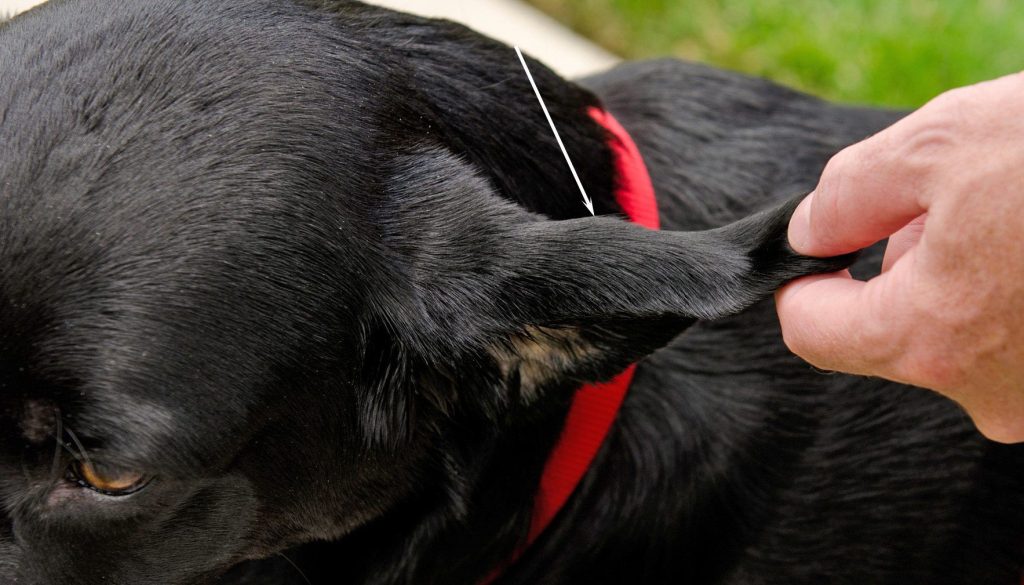Ever rubbed your dog’s ear during a cuddle and suddenly felt a warm, squishy lump that wasn’t there yesterday? Yep.
That little balloon-like swelling is likely a hematoma, and it can be as confusing as it is scary the first time you notice it.

One of my friends was dogsitting her sister’s Eskimo when she noticed his ear had puffed up overnight. The poor guy was shaking his head like he had water stuck in it and pawing at it like it owed him money.
She panicked, called me up, and asked, “Do I need to rush him to the emergency vet or can I do something myself?”
Let’s talk about it, in plain English.
What Is A Dog Hematoma?
Alright, no science class here, promise. A hematoma is basically a pocket of blood trapped under the skin, most commonly in the ear flap (called an aural hematoma).
It usually happens when a dog shakes their head too hard or scratches intensely, causing tiny blood vessels to break.
It looks like a swollen pillow, sometimes soft and squishy, sometimes firm, and it’s usually warm to the touch.
Your dog might act annoyed, or not notice it at all. But most of the time, there’s a reason behind the ear trauma, like allergies, ear infections, or even mites.
When Is It Safe To Treat A Dog Hematoma At Home?
Let’s keep it real, some things are better left to the pros, and draining a hematoma with a needle isn’t something you should be doing in your kitchen.
If the swelling is small, your dog isn’t in pain, and you can see they’re not overly bothered, there are ways to manage it safely at home… for a bit.
But, and this is important, if the swelling gets bigger, starts feeling hot and tight, or your dog starts acting off (like holding their head tilted or getting cranky), it’s time to phone your vet. Fast.
Gentle Ways To Soothe And Support At Home
Okay, now for the part you’re here for. If the hematoma is mild and you’re just trying to keep your dog comfy until the vet appointment, or hoping it reabsorbs on its own, there are a few things you can try.
Use a cool compress to calm the inflammation. Think wet, chilled washcloth, held gently to the ear for a few minutes at a time. No pressure, no wrapping. Just chill, literally.
Keep the dog from scratching or shaking. Easier said than done, yeah? But you can use an Elizabethan collar (cone of shame, bless it) or a soft donut collar to stop them from making it worse.
Some folks swear by natural calming sprays or anti-itch ear cleaners. As long as there’s no open wound and your dog isn’t flinching in pain, mild solutions can help ease the itch that started this whole mess.
When You Should Not DIY
Now listen, if your dog’s ear is swelling fast, feels hard as a brick, or they’re yelping when you touch it, you need a vet. Also, if there’s any sign of pus, crusty wounds, or bleeding, don’t wait.
Hematomas that don’t drain properly can cause the ear flap to scar and crumple into what some call “cauliflower ear.” It’s not just a cosmetic thing, it can affect comfort and even lead to repeated problems.
Bottom line? If you’re unsure, always get a second opinion from your vet. A phone call might be all you need to figure out your next step.
How To Stop It From Happening Again
If your dog has floppy ears or is a known head-shaker (looking at you, spaniels), you’re gonna want to take preventive care seriously.
Articles You Might Love
Start with regular ear checks. A quick peek once a week for wax, gunk, or signs of redness goes a long way.
Allergy management is also key. Dogs that itch constantly from food or seasonal triggers are more likely to damage their ears. Chat with your vet about antihistamines or diet changes if allergies are a recurring issue.
And don’t forget to trim those nails, it helps avoid scratching trauma when the ear starts to itch.
Keep An Eye On The Healing
Even when you’re managing things at home, keep a photo log every few days. That way you’ll catch if the swelling’s getting better or worse.
Look for changes in color, size, or texture. If it goes from squishy to hard, or if it starts leaking anything weird, get it checked.
You can also jot down if your dog starts shaking their head again or scratching more than usual. Those little signs are often the clues we need to spot a deeper problem, like a persistent ear infection that keeps triggering hematomas.
Some Final Thoughts For Fellow Dog Parents
Dealing with a dog hematoma isn’t fun. It looks worse than it feels sometimes, but it can be stressful when you’re not sure what to do or how bad it might get.
Whether you’re in the middle of nowhere or just tight on cash, a little calm care goes a long way.
But don’t beat yourself up if you end up needing a vet. You’re not failing as a pet parent. These things happen, and some pups are just more prone than others.
As always, watch your dog, trust your gut, and lean on your vet when needed.
Have you ever had to deal with a hematoma before? How did your pup handle it?